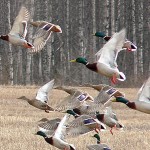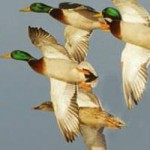LITTLE ROCK – Following a prolonged spell of cold weather in The Natural State as well as frigid temperatures and snow in states to Arkansas’s north, many waterfowl hunters likely expected to see increasing Arkansas duck numbers in recent weeks. But results from the season’s second aerial waterfowl survey paint a different picture.
Arkansas Game and Fish Commission biologists flew the December aerial waterfowl survey Dec. 16-18 in the state’s Delta region and the Arkansas River Valley and Dec. 13 in southwestern Arkansas. The duck population index in the Delta was just over 830,000 ducks, about half of the 2009-2013 average (1.6 million ducks) for the December survey. The mallard population estimate was about 475,000, representing more than half of the Delta total but well below the 2009-2013 December mallard average of roughly 850,000.
In the Arkansas River Valley, the estimated total duck count was 29,000 ducks, including more than 15,000 mallards, and the southwestern Arkansas count was about 29,000 ducks, including just over 10,000 mallards.
Luke Naylor, the AGFC waterfowl program coordinator, said the below-average population index in the Delta illustrates that cold weather and snow in mid-latitude states aren’t the only factors that drive Arkansas duck abundance.
“These systematic surveys continue to point toward habitat conditions – namely flooding extent – playing a major role in Arkansas duck numbers,” Naylor said.
The survey took place last week, just before this duck season’s biggest rain event, which dropped several inches of rain across many parts of the state. Naylor noted that habitat conditions likely have improved dramatically since the aerial survey was conducted, and field reports from AGFC wildlife management areas in this week’s report show a much higher percentage of flooded habitat in areas that previously lacked abundant water.
In the northern Delta, observers reported about 90 percent of habitat was still frozen when the survey started Dec. 16, but much had thawed by the afternoon. Observers noted higher concentrations of ducks as they moved south from the Missouri border. Biologists observed higher concentrations of ducks in the central and southern portions of the Delta. Highest duck concentrations in the Arkansas River Valley were on Lake Dardanelle, and southwestern Arkansas’s highest concentrations were seen along the Red River.
The annual Midwinter Waterfowl Survey is scheduled to begin Jan. 6, and if flooding persists, may provide much different results than the December survey.
[tweet https://twitter.com/mays_porter/status/414835025675177984]









